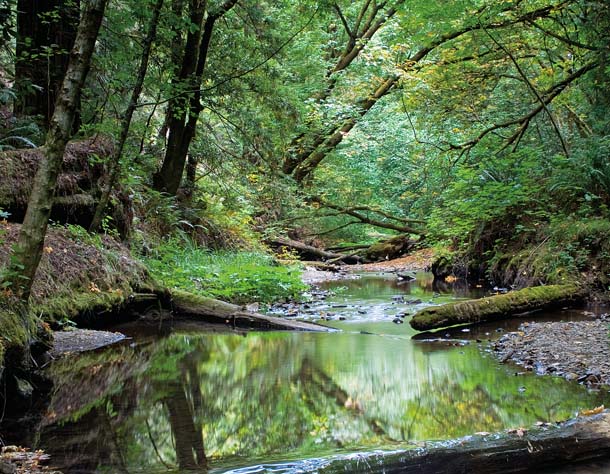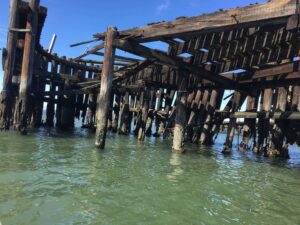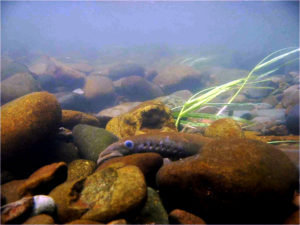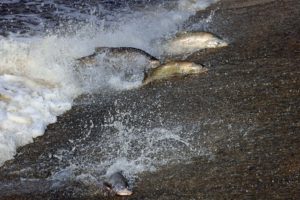“We may be reaching the end of that thread of experience, the end of the dream given by you, Coho, and all your kin.”
Jules Evens wrote that line in “The Dream Given by You,” his feature in the October 2001 issue of Bay Nature. Reading about his encounters with coho salmon on Lagunitas Creek got me thinking. Where I live on the San Mateo coast, a small number of coastal creeks have also supported runs of coho at the extreme southern end of their range, and I wondered if their runs still survived. Perhaps, with some luck, I could also spot coho in my “home waters.”
I’m not a fisheries biologist but a fly fisherman who’s curious and concerned about what is happening to the coho. I knew their populations south of San Francisco were in big trouble, so if I wanted to see them near my home in Half Moon Bay, I had no time to waste. I picked up historical stream surveys, biological reports, and creek maps. I watched the weather and hoped for big December rains, which trigger the run of adult salmon back to their natal streams.
I knew finding these fish would be difficult, even if they were there. Coho return to spawn when stream flows run high and off-color due to high sediment loads. The fish prefer the cover of darkness for moving upstream and typically build their nests, or redds, in the most remote stretches.
From the time my dad taught me to fish, I’ve spent countless hours in and around water–always looking for “holding” fish, those staying mostly still in the water, just dark shadows moving subtly over the streambed.
I knew from reading survey results that the numbers of spawning adults were dreadfully low. But I had questions beyond the numbers: Did these creeks have barriers to fish passage? Had logging in these watersheds increased the sediment load for these creeks? Were the winter flows not strong enough to open the creek’s mouth to the ocean? Only by seeing these creeks firsthand could I learn about the real challenges confronting these fish.
I left my reel at home and packed my binoculars instead, but spotting these fish turned out to be much harder than I expected. The winter seasons of 2009 through 2011 passed without my seeing a single coho south of San Francisco, even though I walked and waded miles of Gazos, Waddell, and Scott creeks.
Were they there, and I just wasn’t seeing them? Or, a more depressing thought, were they not there to be seen? To find out, I decided to expand my creek hikes into the summer months, in search of juveniles.
Summer on Scott Creek
Adult coho spend their lives in the open ocean and, after three years at sea, return to their birth streams once the winter rains have begun. So outside of winter, you’ll find only juveniles in local streams. You make a trade-off when you look for juveniles in summer instead of adults in winter. The weather is, of course, much warmer and drier, but instead of looking for a 20-inch fish, you’re looking for a target less than three inches long. During one such trip to Scott Creek north of Santa Cruz, in late summer of 2010, bright sun combined with an absence of onshore wind to heat the Santa Cruz coast to 80 degrees.
Driving south along Highway 1 past Waddell Beach, I turned left onto Swanton Road. At the summit of the hill, a view to the east revealed a landscape charred by the 2009 Lockheed Fire, which had burned though much of the Scott Creek watershed over two weeks, nearly taking out a fish hatchery on Big Creek. Coming down the backside of the hill, I arrived in the Scott Creek Valley. I parked at a bridge near the old Seaport School and put on my wading boots. Low summer flows would make a walk in the creek much easier than pushing through the thick bank-side wall of willow, alder, and poison oak. But even with less water running, progress here was slow. Approaching a small pool, I could see fish darting for cover. Waiting quietly for a few minutes brought them back, and that’s when the identification began. Looking through my binoculars, I saw that most had spots on the dorsal fin, a trait of rainbow trout. After several hours spotting in the stream, I saw only juvenile trout and not a single coho.
That result is not such a surprise. In a 2008 survey conducted by the National Oceanic and Atmospheric Administration (NOAA) in San Mateo and Santa Cruz counties, juvenile coho were found in extremely small numbers, and in only five of 11 watersheds. In two watersheds, Scott and Waddell creeks, survey teams tallied only four and 34 juvenile fish, respectively, in over eight miles of channel. And in 2010, for the first time in 19 years of monitoring, Jerry Smith of San Jose State University found no juvenile coho in Scott, Waddell, or Gazos creeks. Again in 2011, Smith’s survey came up empty.
So according to the experts, the coho simply weren’t there to be seen. What had happened? Researchers have zeroed in on poor ocean conditions as one likely cause, and the impact rippled inland as well. Changes in ocean surface temperatures led to more frequent El Niños, says Smith, which meant bigger storms washing away more redds, killing eggs and juveniles. Even fish that survived faced starvation when they got to sea, due to changes in the coastal upwelling that drives the productivity of Northern California’s marine environment. Upwelling drives cold, nutrient-rich waters to the surface and sets off cycles of plankton production that reverberate up the food chain to top predators like salmon. Many scientists now think that poor upwelling from 2005 to 2008 meant very lean years for salmon and other creatures that live offshore.
While coho from watersheds north of San Francisco suffered the same troubles and saw population declines as well, they were starting from a higher baseline. Lagunitas Creek, located in west Marin County, currently supports the Central Coast’s largest run of wild coho salmon. Neighboring Redwood Creek has also been somewhat of a stronghold for wild coho. However, with no coho spawners observed in the winter of 2007–2008, Redwood Creek’s coho also appeared to be in decline. I decided to head north to find out what was being done to address this.
Seeking Slow Water
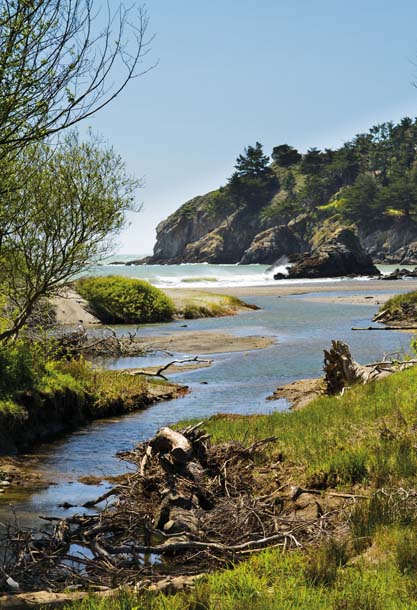
Some 150 years ago, a coastal lagoon expanded behind Muir Beach, where Redwood Creek meets the ocean. The lagoon provided acres of slow, open water for fish and other wildlife. Such brackish water habitat near the ocean is essential for fish like salmon, which need to undergo a physiological change before they leave freshwater streams for the ocean. But subsequent human settlement brought a levee, a bridge, and a parking lot to the banks of Redwood Creek. The creek, no longer capable of expanding into its natural floodplain, was encased in an earthen straitjacket.
That’s now changing. I came to Muir Beach to meet Carolyn Shoulders, a restoration project manager with the National Park Service who sits here at a busy intersection of science, backhoes, and a small army of consultants, staff, and volunteers?–?directing traffic. For almost a decade, she’s managed a complete transformation at Muir Beach.
Before a single shovel of dirt was moved for the project, fisheries biologists surveyed Redwood Creek upstream of Muir Beach. They discovered something troubling: very few places for juvenile coho to escape fast water. These tiny fish cannot survive in fast water and must swim to slow-moving backwater or “off-channel” pools to avoid getting swept downstream during periods of high flow.
“In our design revisions,” she explained, “we added a lot of specific features for off-channel habitat for coho.” As we walked the edges of Redwood Creek, she pointed out a few of those. “That’s the old creek channel. It will now provide backwater habitat for coho.” Directly across from the old channel, workers from the National Parks Conservancy were busy planting stream banks that lead to a much larger backwater, one of six off-channel habitats created by the restoration.
A variety of native species, including threatened red-legged frogs and steelhead trout, are certain to welcome a more naturally functioning ecosystem. Shoulders outlined the restoration’s numerous benefits beyond just helping coho. “Starting out, our goal really wasn’t just to increase the population of coho in our system,” she explained. “However, if that happens it would be one of the most outstanding results we could have.”
Several miles north of Redwood Creek, the Lagunitas watershed–a historic coho stronghold–has also lost slow water habitat for young salmon.
From a legal perspective, this watershed serves at least three masters. The National Park Service calls the shots in the lower reach, where the creek empties into Tomales Bay. Samuel P. Taylor State Park covers the middle portion, while the headwaters fall under the jurisdiction of Marin Municipal Water District.
Todd Steiner, executive director of the Salmon Protection and Watershed Network (SPAWN), tells me that the headwaters section typically has about half of the spawning activity. “You would think if you’re a fish that you’d want to spawn in that protected national and state park area with the big, beautiful redwood trees. But they don’t, because these fish have evolved to spawn in tributaries.”

As I drove along Sir Francis Drake Boulevard with Steiner and SPAWN watershed scientist Aaron Fairbrook, they pointed out how homes along the creek east of the state park alter the landscape. Steiner is most worried about roofs and traditional landscaping (e.g., lawns). It’s not just one roof, but a suburb of roofing. Rather than getting absorbed in the ground, rainwater runs off from roofs and driveways into creeks or storm drains, greatly magnifying the flows in important spawning tributaries like San Geronimo Creek.

Steiner says the answer lies in a simple device, the rain barrel. “If you catch that rain in a barrel or a big cistern, then you can take the peak off the storm events.” Besides reducing peak flows in winter, rainwater harvesting lowers demands on treated water supplies for landscaping, reduces flooding and erosion, and ultimately improves fish habitat. In 2010 alone, SPAWN built five demonstration rain gardens and completed 67 rainwater harvesting consultations for residents throughout Marin County.
Harvesting rainwater, adding backwater habitat, and restoring floodplains represent critical improvements to facilitate coho survival in their respective watersheds. But what can be done in watersheds where coho have all but vanished? To answer that question, I drove back across the Golden Gate, heading south for home.
Betting on Brood Stock
Two men wade ankle deep in water inside an above-ground pool. They hold what look like long-handled pool skimmers while staring down at the water. It’s a cleanup operation. Russell Enriquez, the assistant hatchery manager, pushes his net along the bottom of the pool. “Got a large one.” As Enriquez lifts the net, a 21-inch-long, bright silver coho shakes hard, throwing water in all directions.
“Now that’s what I call fishing,” someone says, grinning.
But the dozen people gathered at the Big Creek Hatchery aren’t here to fish. On this summer morning, eight volunteers along with hatchery personnel and fisheries biologists from NOAA are moving several hundred adult coho to their new home at the hatchery.
Once netted, the coho get unceremoniously placed in a large, sterile garbage can partly filled with water and carried off to the new pool. Every fifth fish is taken by Dave Streig, the longtime hatchery manager at Big Creek. “Forty-six,” Streig yells out after a length measurement. A NOAA biologist notes 46 centimeters on her clipboard.
The size of these adults will be monitored closely until the end of the year. They need to grow in size and strength to reach reproductive maturity. Sometime between late December and early January the coho reaching full reproductive development will spawn at the hatchery.
I grab one handle of the garbage can and NOAA fisheries biologist Erik Sturm takes the other. We scramble up a short path and lift the 12 gallons of water and four coho over the wall of the new pool. Then we stand at the edge of the pool and watch our fish quickly swim into the mix of other coho. A pump circulates water, creating a steady current that’s important for these fish. “It forces them to work,” Sturm says. “Swimming against a steady current will strengthen them.”
Ideally these coho would have grown strong in the ocean before migrating back to Scott Creek. Unfortunately, not enough wild coho spawned in 2008 to keep this run going. Without this hatchery maintaining a brood stock, the unique genetics of Scott Creek coho would have vanished.
But hatcheries have gained a sometimes justified bad rap in fish restoration circles. It’s not true that a coho is just a coho. Each wild coho comes from, and returns to, a specific watershed. So a coho from the Klamath River is different genetically than one from the Russian River. Unfortunately, traditional hatcheries have focused more on pumping out fish than on maintaining strong genes. Mounting evidence points to a decline in the long-term fitness of wild salmon populations when their hatchery counterparts compete for food and habitat.

So in 1994, the National Marine Fisheries Service recommended that salmon hatcheries eliminate the practice of transferring salmon between different streams.
Armed with increased knowledge of cell biology combined with technology to analyze genetics, California fisheries managers are pushing ahead with the use of captive brood stock to restart lost runs or runs near collapse. Brood stock coho are the progeny of wild fish collected from their native stream.
The hatchery I visited near Scott Creek is one such brood stock program, which grew out of a cooperative effort between the Monterey Bay Salmon and Trout Project (MBSTP) and the National Marine Fisheries Service (NMFS), using coho from Scott Creek in Santa Cruz County.
The NMFS’s Santa Cruz office works closely with MBSTP to apply complex breeding strategies. With the goal of maximizing variation in DNA and minimizing inbreeding, geneticist Carlos Garza inspects each spawning adult’s DNA before breeding. Garza says brood stocks will play a critical role in recovery of declining coho runs.
How that plays out here remains to be seen. Up north, in response to the grave status of Russian River coho, a brood stock program has been under way for a decade. The California Department of Fish and Game collected juvenile coho native to the Russian River watershed and placed them in the Warm Springs Hatchery on Dry Creek below Lake Sonoma. These juveniles were reared to adults, they spawned, and their offspring were released throughout the Russian River watershed in fall 2004.
A significant rebound in returning adults for the Russian River was slow to materialize, but recent results show more promise. In the winter of 2010–2011, an estimated 190 adult coho returned to the Russian River watershed, the largest such return since the population crashed in 2000. Faced with dwindling runs in other North Bay streams, state and federal officials are seriously considering expanding the brood stock program to stem further declines of coho salmon in Marin, Sonoma, and possibly Mendocino counties.
From on-the-ground habitat restoration to water conservation advocacy to reimagined fish hatcheries, the efforts to save the coho are broad and diverse. But it’s too early to say whether they’ll also be successful.
Until that chapter is written, I’ll continue walking the creeks near my home, looking closely and hoping to witness the return of my local coho.


